 Image search results - "dotaku" Image search results - "dotaku" |
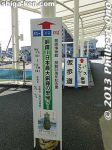
Dotaku means bronze bell. Yasu is the site of the discovery of Japan's largest ancient bronze bells. The Dotaku Bronze Bell Museum (Dotaku Hakubutsukan) explains the history and discovery of Yasu's bronze bells.
|
|

During Oct. 5 to Nov. 24, 2013, for the first time since its discovery in Yasu in 1881, Japan's largest bronze bell was exhibited at the Dotaku Bronze Bell Museum. Buses to the museum ran from Yasu Station.
|
|
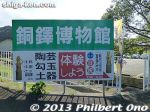
Dotaku Museum sign. The museum is open 9 am to 5 pm, closed Mon. (open if national holiday). From JR Yasu Station’s South exit (Minami-guchi), take a bus going to Karyoku Koen (花緑公園) or Murata Seisakusho (via Nishi Gate 西ゲート経由 村田Get off at Dotaku Hakubutsukan-mae (銅鐸博物館前). Bus ride is only a few minutes. From bus stop, cross the road to get to the museum.
|
|

Sign for the homecoming exhibition of Japan's largest dotaku bronze bell during autumn 2013.
|
|

"Dotaku" means bronze bell. This one decorates the entrance of the Dotaku Museum in Yasu. Map
|
|
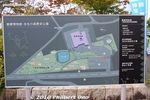
Map of the Dotaku Museum and Yayoi no Mori Park featuring Yayoi Period grass shacks. Dotaku Museum is a short bus ride from JR Yasu Station. Take the bus which goes to Dotaku Hakubutsukan-mae.
|
|

Dotaku Museum in Yasu, Shiga Prefecture. Opened in Nov. 1988, the museum is near the site where Japan's largest bronze bell was unearthed. It has bronze bell exhibits and research facilities. Open 9 am to 5 pm (closed Mon.). Admission 400 yen.
|
|

Museum entrance with a sign indicating the Homecoming Exhibition for Japan’s Largest Bronze Bell to mark the museum's 25th anniversary.
|
|

On Aug. 20, 1881, two young lads were playing on Mt. Oiwa when they stumbled across three dotaku partially exposed in the ground. The next day, eleven more dotaku were discovered in the same area.
|
|

Replica of Japan's largest dotaku found in Yasu.
|
|

Replica of Japan's largest dotaku found in Yasu.
|
|
|
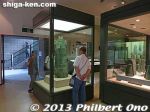
Japan's largest dotaku bronze bell on a special homecoming display at Dotaku Museum in Yasu, Shiga.
|
|
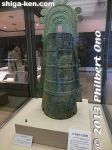
Japan's largest dotaku bronze bell is 134 cm high and dated from around 100 BC to 300 AD (Japan’s Yayoi Period).Dotaku bells in Kinki area are known for their protruding "ears," whereas dotaku found in Shizuoka (another dotaku hotbed) usually don't have ears.
|
|
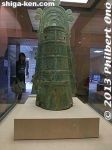
Japan's largest dotaku bronze bell on special display at Dotaku Museum in Yasu, Shiga. This bell was used as a religious ceremonial piece rather than as a real bell.
|
|
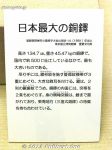
About Japan's largest dotaku bronze bell.
|
|
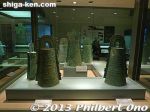
A whole bunch of other dotaku were found in the same area as late as 1962. Most of the bells displayed are replicas, but a few are genuine.
|
|
|
|
|
|
|
|
|
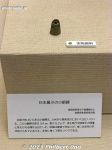
Japan's smallest dotaku. 3.4 cm high.
|
|

Normally, the largest dotaku is not exhibited here. It is in the Tokyo National Museum.
|
|

This is how the dotaku were buried.
|
|

The dotaku were nestled inside each other. These bells are dated from around 100 BC to 300 AD. The bells were not really used as bells. They were more for decorative and religious purposes.
|
|
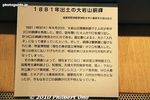
Two of the dotaku were acquired by the Tokyo National Museum. The remaining dotaku were scattered among various people. Their whereabouts were unknown until an investigation found 12 of them at temples and Japanese and overseas museums.
|
|

Mold for making a dotaku. Yasu's dotaku found their way to the following overseas museums: Museum of East Asian Art in Cologne (Germany), Asian Art Museum of San Francisco (USA), and Minneapolis Institute of Arts (USA).
|
|
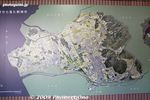
Satellite view of Yasu.
|
|
|

Monument marking the site where the dotaku were found. It's frustrating that none of the original dotaku discovered in Yasu are in Yasu. Another case of bungling and ineptness by local officials. Even one original dotaku would make the museum busier.
|
|

Monument marking the site where the dotaku were found. In 1962, ten more dotaku were found in Yasu.
|
|

Yasu's official mascot, named Dotaku-kun, is modeled after a dotaku.
|
|

Adjacent to the Dotaku Museum is a replica of a Yayoi Period village. Yayoi Period (500 BC to 300 AD) is noted as when rice growing started in Japan.
|
|

These ancient abode were pretty much a hole in the ground with a roof over it.
|
|
|
|
|
|

Inside a Yayoi-Period grass shack.
|
|
|
|
|
|

The ceiling has square beams.
|
|
|
|

Some pots inside a hut.
|
|

It would be a matter of time before walls were constructed below the roof.
|
|
|
|
|
|

This elevated structure served as a storehouse.
|
|
|
|
|
|
|
|

From JR Yasu Station's South exit (Minami-guchi), take a bus going to Karyoku Koen (花緑公園) or Murata Seisakusho (via Nishi Gate 西ゲート経由 村田製作所行き) and get off at Dotaku Hakubutsukan-mae (銅鐸博物館前). Bus ride is
|
|

Yamanokami mountain god monument
|
|
|
|
|
|